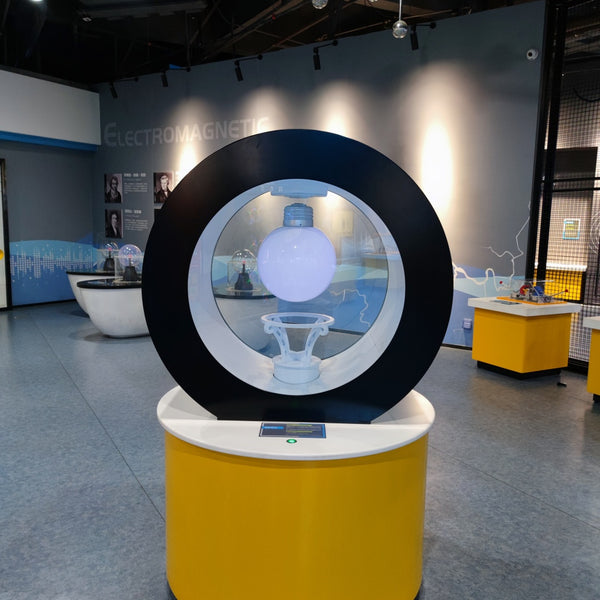The Ultimate Guide to Designing an Interactive Science Exhibit: Lessons from Pingxiang Science Museum

Designing an interactive science exhibit that captivates, educates, and inspires visitors is a challenging task that requires both creativity and technical expertise. At Pingxiang Science Museum, we've developed a successful approach that combines audience engagement, innovative design, and cutting-edge technology. One of our most remarkable exhibits is the Magnetic Levitation Light Bulb—a giant bulb that appears to float in mid-air thanks to magnetic forces. In this guide, we will explore the key principles and strategies used in designing top-tier interactive exhibits, with a special focus on our Magnetic Levitation Light Bulb exhibit.
Understanding Your Audience
A deep understanding of your audience is crucial when designing interactive science exhibits. At Pingxiang Science Museum, our exhibits cater to a wide range of visitors, from young children to adults with varying levels of scientific knowledge.
- Age-Appropriate Content: We tailor our exhibits to suit different age groups. For younger audiences, we provide hands-on activities with simple explanations, while more complex scientific theories are reserved for older, more knowledgeable visitors.
- Cultural Relevance: Our exhibits are designed with the cultural and social context of our audience in mind. This approach ensures that the content is not only educational but also relatable and impactful.
Core Design Principles for Interactive Exhibits
The design of an interactive exhibit is crucial to its success. At Pingxiang Science Museum, we adhere to several key design principles to ensure our exhibits are both educational and engaging:
- Simplicity and Clarity: We prioritize clear and simple designs that allow visitors to focus on the content without unnecessary distractions. This includes intuitive navigation, straightforward information displays, and easy-to-understand interactive elements.
- Interactivity: Making exhibits interactive is essential for visitor engagement. We use a variety of interactive elements, such as touchscreens, physical controls, and motion sensors, to make the learning experience more dynamic and engaging.
- Aesthetics and Functionality: Our exhibits are designed to be visually appealing while also being user-friendly and educational. The balance between aesthetics and functionality is key to attracting and retaining visitor interest.
The Magnetic Levitation Light Bulb: A Case Study
One of the highlights of Pingxiang Science Museum is the Magnetic Levitation Light Bulb exhibit. This exhibit is a prime example of how technology, design, and science can come together to create an unforgettable visitor experience.
- Technology Integration: The Magnetic Levitation Light Bulb uses advanced magnetic levitation technology to keep a giant light bulb suspended in mid-air. This not only creates a visually striking effect but also serves as a practical demonstration of scientific principles like electromagnetism and stability.
- Visitor Engagement: Visitors are encouraged to interact with the exhibit by adjusting controls that influence the light bulb’s height and stability. This hands-on interaction helps visitors understand the scientific principles at play while making the learning process fun and memorable.
Engaging Visitors Effectively
Visitor engagement is a key factor in the success of any exhibit. At Pingxiang Science Museum, we use a variety of strategies to keep visitors engaged and ensure they leave with a deeper understanding of the scientific concepts presented:
- Storytelling: We incorporate storytelling into our exhibits to make complex scientific concepts more relatable. For example, the Magnetic Levitation Light Bulb exhibit includes a narrative about the history and future of magnetic technology, making the science behind it more accessible.
- Gamification: Adding elements of play, such as challenges and rewards, can significantly enhance visitor engagement. In our Magnetic Levitation Light Bulb exhibit, visitors can challenge themselves to keep the bulb levitating for as long as possible, turning the experience into a fun and educational game.
- Social Interaction: Our exhibits are designed to encourage interaction not just between the visitor and the exhibit, but also among visitors. This social aspect makes the experience more engaging and encourages collaborative learning.
Continuous Improvement Through Feedback
No exhibit is perfect from the start. At Pingxiang Science Museum, we continually refine our exhibits based on visitor feedback. This process of continuous improvement ensures that our exhibits remain relevant, engaging, and educational over time.
Conclusion
Designing an interactive science exhibit is a complex process that requires careful consideration of audience needs, design principles, technology integration, and visitor engagement strategies. The Magnetic Levitation Light Bulb exhibit at Pingxiang Science Museum is a perfect example of how these elements can be combined to create an exhibit that is both educational and inspiring. By applying these lessons, you can create interactive science exhibits that are not only successful but also leave a lasting impact on your visitors.
Call to Action: If you're interested in experiencing cutting-edge interactive science exhibits, visit Pingxiang Science Museum. Our expertly designed exhibits, including the mesmerizing Magnetic Levitation Light Bulb, offer something for everyone, from students and educators to science enthusiasts. Come and discover the wonders of science in a whole new way!
